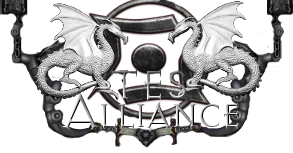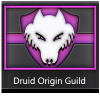How I created Wallpaper Panels in Skyrim This would not have been possible without the unending guidance and support received through The Enclave. Participating in the Graphic Artistry Course began this quest of mine with InsanitySorrow and Hanaisse offering guidance to help me reach my goal. My instructions assume basic understanding of steps taken in Graphic Artistry Lesson #1 and Lesson #2 What you will need: Gimp or PS; I used PS (I hope things are the same) Brushes for Gimp or PS (Grunge, spatters, spills, peels) I found some for PS here and here and here (Please give credit where credit is due) 512 x 512 wallpaper image of your choice (I made my own from free wallpaper samples) Wall kit piece Meshes and Textures (I used smdewalsol05.nif and swoodplanks01.dds) Nifskope Place the mesh and textures (including the wallpaper pattern; it can be removed later) to be used in their proper places in the data directory. Because of the trial and errors I went through I do things a bit backwards to the steps I learned in Graphic Artistry, but it produces the results I desire. The goal is to have rips and tears visible and enhanced with the normal map, but not the pattern on the wallpaper. To do this, I begin with the tears and rips in the paper. I work with 3 layers, two we have in place and one will be created for temporary use. In Gimp or Photoshop Open the stock wall texture (swoodplanks01.dds) Open the wallpaper image texture to be used. Open a new file sized 512 x 512 On this image fill it with a color similar to the wallpaper. Do this by selecting the Paint Bucket Tool and picking a color from the palette. There are now 3 tabs open which make our layers, copy and paste them on top of the stock wall texture in this order: Wallpaper texture Solid Color image The layers should appear like so: Using an assortment of brushes (scratches, peeling, etc) any type which would expose the wood beneath begin by applying them to the Solid Color Image first. Select the eraser tool and a grunge brush tip. Be sure to check the opacity; for these 100% is usually best. Lining the selected grunge brush up check the measurements on the ruler; click to remove the selection on the Solid Color Image. Navigate to Layer 1 (the wallpaper) align the brush in the same spot and click to remove the selection to satisfaction. (How much damage wanted). Navigate between the layers until the amount of damage desired has been applied. At this point I create my normal map. Navigate to layers and select merge all visible. Navigate to Filter and select normal map I select 4 sample with a scale of 1.5 to 1.7 (personal preference, but I found this to produce nice results). File save as: Whateveryouwant_n.dds DXT1 No Alpha (To prevent shininess on wallpaper or a wet paint look) Return to your normal mapped image and step backwards until you have the filter removed and the layers separated again. Delete the solid color image layer. Merge the remaining two layers and using grunge brushes select a color suitable for the desired effect and apply. Change brush tips and colors for a variety; grunge until desired effect is reached. This is the final product and what will show in game. File save as: Whateveryouwant.dds DXT5 Discard any of the images not needed (solid color image/wallpaper pattern) NifSkope Magic In Nifskope we will attach our wallpaper panel to the mesh and eliminate the shader which caused an unattractive beveled look to the finished wallpaper texture. In Nifskope Load the mesh (smdewalsol05.nif) In the render window click on the portion of the wall which will display the wallpaper, this selects the proper block details and highlights it in the left panel (Block details). Click on the + and expand the selection to expose the NiTriShapeData, BSLightingShader and BSShader Texture headers in the block list. Click on NiTriShapeData doing this will display a huge list of details in the bottom pane of Nifskope. Find Vertex Colors and click on the + expanding the individual colors used, each one in the section needs to be changed to white. Do this by: Click on the Color Wheel find and select white Or Double Click on the #panel and fill in the boxes with 1.00 all the way across. Now go back up to the Block List and click on BSShader Textures and add the normal map and texture in the lower panel as described in Lesson #2, ensuring after loading your textures any words in the path string before Textures has been removed. When all the changes needed have been made, save the file as Somethingyourecognizebutisnotvanilla.nif The wallpaper panel is now ready to be added in the CK for use as explained in lesson#2. Credits go to: The Enclave (DarkRider's TES Alliance) Insanity Sorrow Hanaisse Image #3 IS WillieSea, camaro_69_327 and all the other fine folks who offered suggestions!





